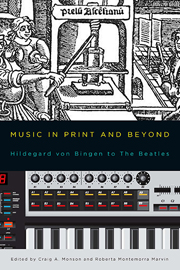Book contents
- Frontmatter
- Dedication
- Contents
- Acknowledgments
- Introduction
- 1 Robert Granjon and Music during the Golden Age of Typography
- 2 Publishing Music Theory in Early Cinquecento Venice and Bologna: Friends and Foes
- 3 Preaching to the Choir: Arts of Persuasion in the Converts of Italy
- 4 Music Distribution in London during Handel's Lifetime: Manuscript Copies versus Prints
- 5 Beethoven's Miniatures
- 6 “The Beautiful and the Ugly”: Travel Literature, Racial Theory, and a Schumann Song
- 7 Verdi's “Music of the Future”
- 8 The Suspended Voice of Amália Rodrigues
- 9 More than Mostly Mozart: Teddy Wilson's “China Boy”
- 10 Wanted Dead and Alive: Historical Performance Practice and Electro-Acoustic Music from IRCAM to Abbey Road
- 11 Lowinsky's Secrets
- 12 The Unknown Hildegard: Editing, Performance, and Reception (An Ordo Virtutum in Five Acts)
- List of Contributors
- Index
9 - More than Mostly Mozart: Teddy Wilson's “China Boy”
Published online by Cambridge University Press: 05 March 2014
- Frontmatter
- Dedication
- Contents
- Acknowledgments
- Introduction
- 1 Robert Granjon and Music during the Golden Age of Typography
- 2 Publishing Music Theory in Early Cinquecento Venice and Bologna: Friends and Foes
- 3 Preaching to the Choir: Arts of Persuasion in the Converts of Italy
- 4 Music Distribution in London during Handel's Lifetime: Manuscript Copies versus Prints
- 5 Beethoven's Miniatures
- 6 “The Beautiful and the Ugly”: Travel Literature, Racial Theory, and a Schumann Song
- 7 Verdi's “Music of the Future”
- 8 The Suspended Voice of Amália Rodrigues
- 9 More than Mostly Mozart: Teddy Wilson's “China Boy”
- 10 Wanted Dead and Alive: Historical Performance Practice and Electro-Acoustic Music from IRCAM to Abbey Road
- 11 Lowinsky's Secrets
- 12 The Unknown Hildegard: Editing, Performance, and Reception (An Ordo Virtutum in Five Acts)
- List of Contributors
- Index
Summary
“I was inspired to copy jazz piano solos by giants like Fats Waller and Earl Hines whom I admired and wanted to emulate. I copied the solos from records note for note and memorized them …. That was the way all pianists learned in those days.”
—Teddy Wilson, Teddy Wilson Talks Jazz“Of course, all improvisation is part prestidigitation. The musician has his formulas, as the conjuror has his tricks.”
—Joseph Kerman, “Text and Act: Beethoven's Concertos”Jazz scholarship is among the younger humanistic disciplines. It began to gain traction only in the 1970s with the advent of the first jazz history textbooks, a few scholarly papers and articles, and, most important, The Smithsonian Collection of Classic Jazz (1973), a compilation of recorded performances selected almost exclusively by jazz critic Martin Williams. The conjunction of this publication activity, together with the American bicentennial celebration in 1976, however, gave a noticeable impetus to academic jazz studies. As university courses in the area proliferated in the ‘70s and ‘80s, The Smithsonian Collection took on the aura of a canon, and over time, its performances, reflecting essentially one aficionado's views, became the basis of a settled jazz history narrative. That narrative was inherently incomplete, excluding numerous recordings, unissued as well as issued. Its work-centered approach also overlooked such crucial variables as the ways in which performers conceived, shared, taught, and transmitted their music; evolving performance environments; audience responses; and the impact of sociocultural and political factors on the music's meaning and reception.
- Type
- Chapter
- Information
- Music in Print and BeyondHildegard von Bingen to The Beatles, pp. 200 - 212Publisher: Boydell & BrewerPrint publication year: 2013

